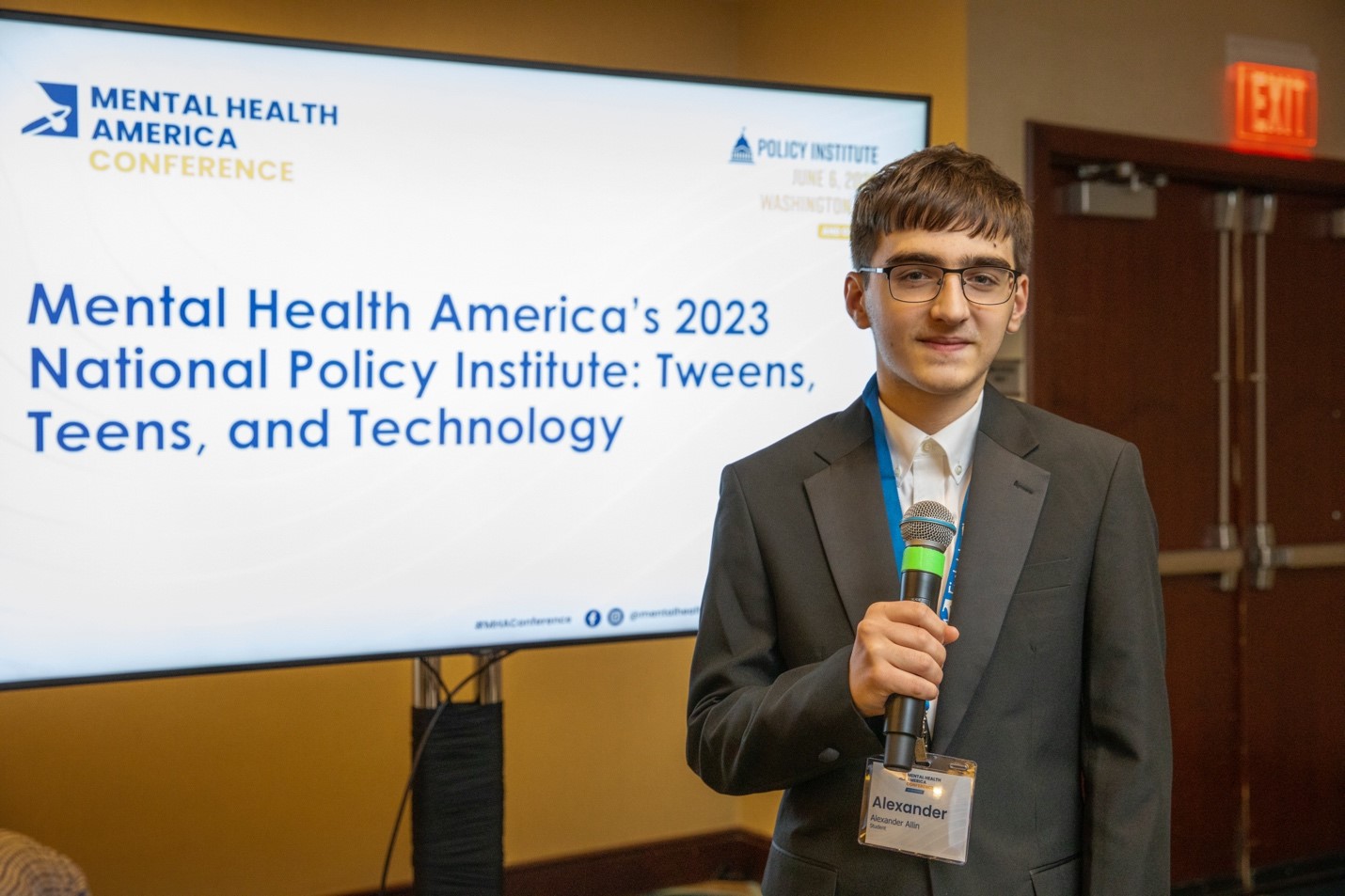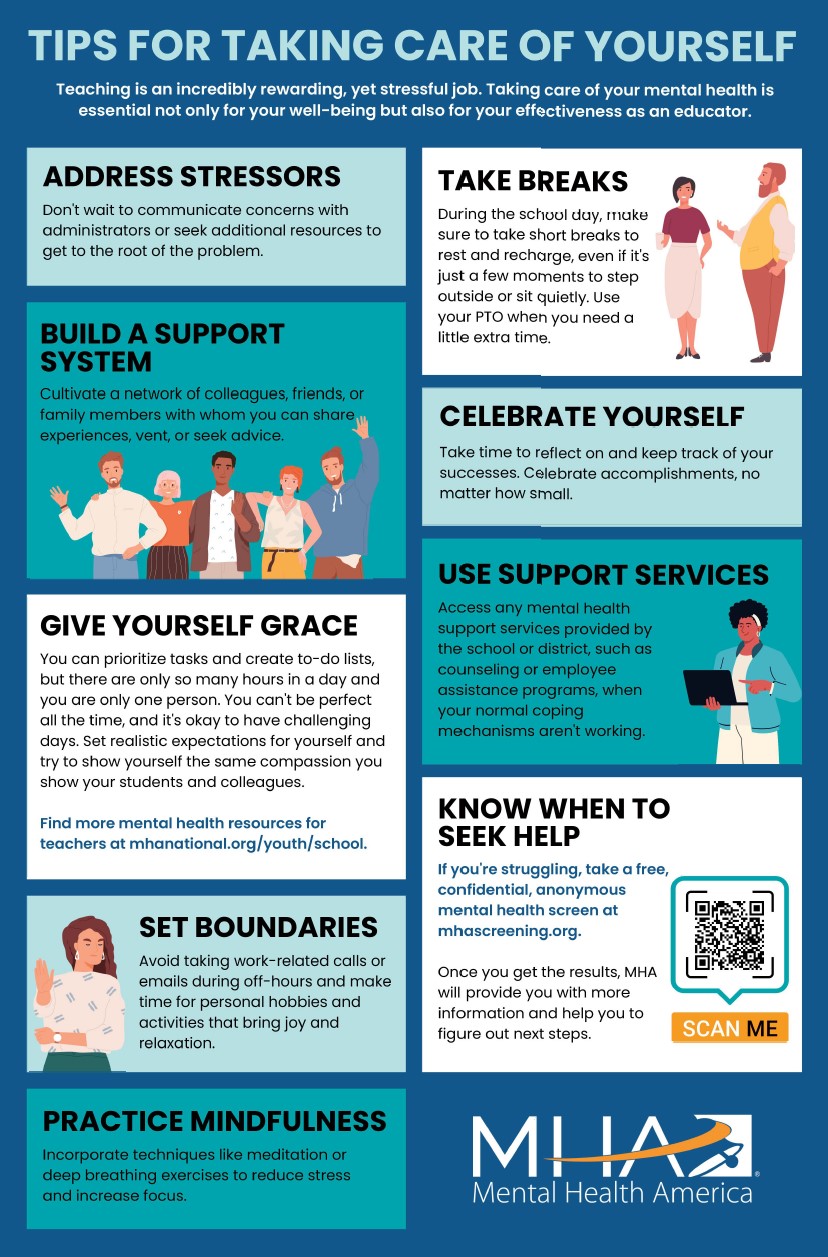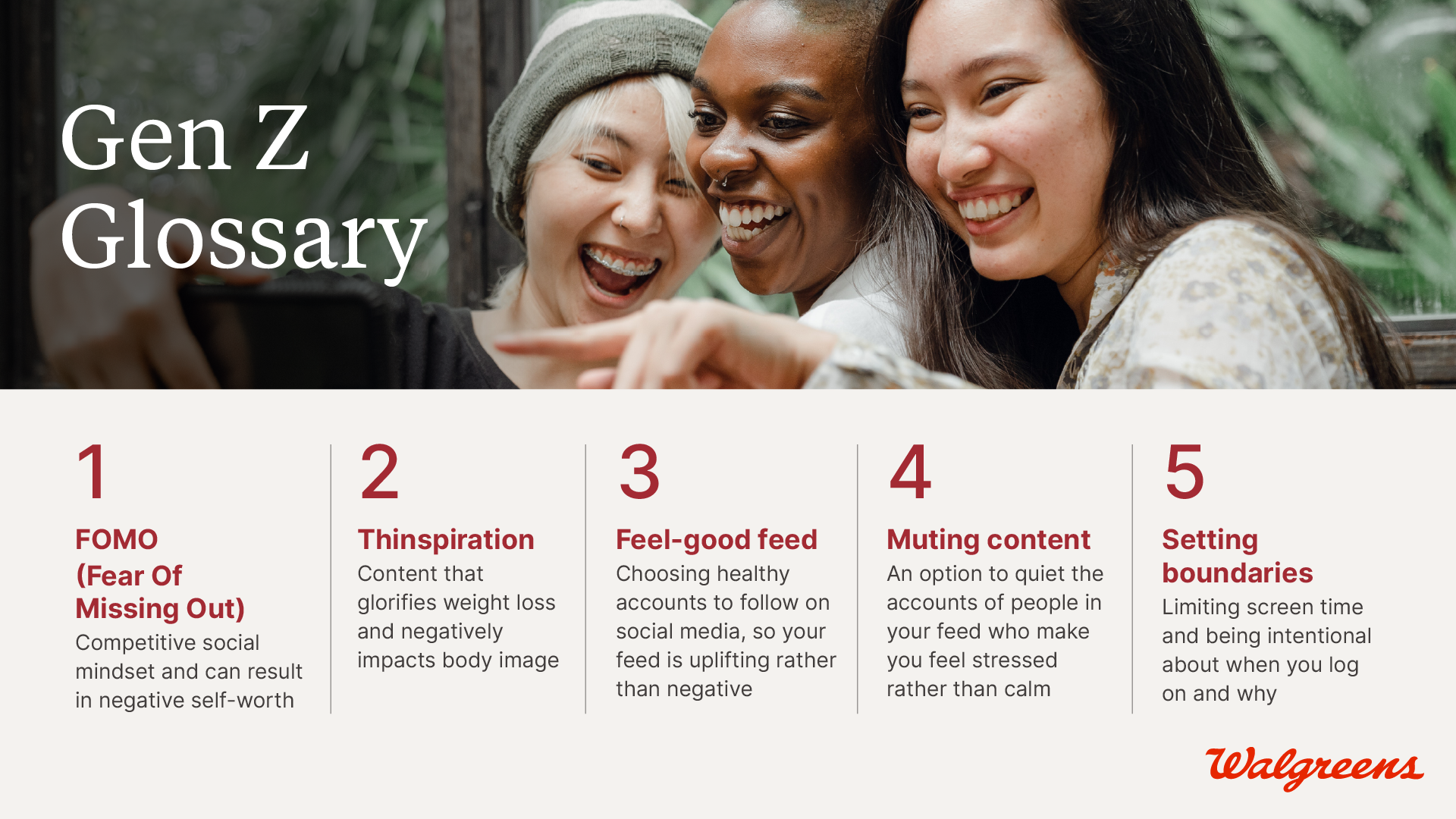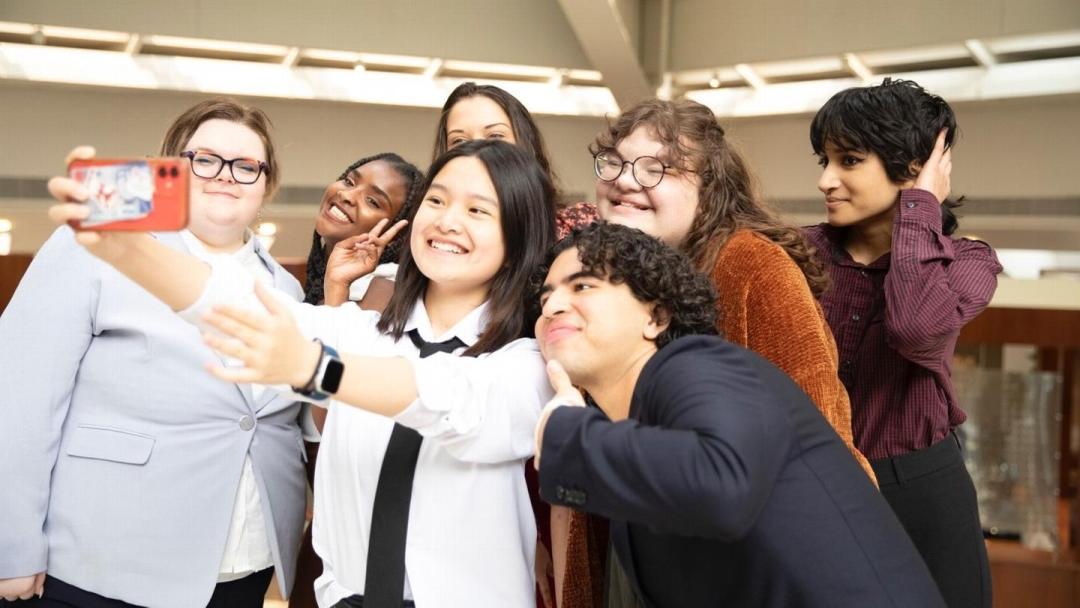Homework assignments, TikTok challenges, test scores, teacher emails, DMs ... it’s stressful just to imagine the life of a teenager. Add in the transition of going back to school from summer break, and the stressors and pressure can quickly take a toll.
If anyone can relate, it’s Alex Allin, an incoming high school junior at the Montgomery County Public Schools district in Rockville, Maryland. While his high school implemented a “no phones” policy last year, feelings of stress and anxiety still follow his classmates during the school day.
“We get constant [online] notifications whenever we get a graded quiz or assignment back that adds pressure because it’s a number that kind of defines your future,” explains Allin. “Such instant academic feedback can be really overwhelming if you know you didn’t do well on a test and then later the same day you actually see that you didn’t do well.”
He’s voicing his experience through his work with Mental Health America (MHA), a Walgreens strategic partner since 2016, where he’s served as a youth leader for the Our Future in Mind program and co-led a session at MHA’s annual conference that offered a student perspective on advocacy initiatives.
After seeing people in his community self-harming or contemplating suicide, Allin became even more passionate about contributing to positive change. “These experiences made me want to help them and others, and when I experienced my own mental health issues when starting high school, I became a bigger advocate in my community and started to be more involved in advocacy,” he says.
Co-authored and sponsored by Walgreens, the downloadable collection of articles, expert advice and resources offer support during the often-rocky back-to-school adjustment period. The resource is also being made available at the more than 800 schools Walgreens partners with through the Expressions Challenge Initiative.
This year’s toolkit theme is, “Selfies, Social & Screens: Navigating Virtual Spaces for Youth,” as it aims to address some of the key drivers that are negatively impacting kids today. It’s also a reaction to the U.S. Surgeon General’s Advisory on Social Media and Youth Mental Health announced in May. The advisory noted an uptick in mental health issues in young people, such as depression, anxiety and suicidal thoughts, and attributed much of it to digital stressors. Alex Allin co-leads a session at Mental Health America’s annual conference in June 2023.What’s Allin’s take? “I thought the toolkit was really detailed and brought light to a lot of issues that I think students might not realize in themselves are a problem, like how social media really impacts a person's body image and is an addiction,” he says. “Some of the tips that resonated with me were those that told youth to focus on meaningful conversations and connections, just focusing on the people who matter in their life.”
Alex Allin co-leads a session at Mental Health America’s annual conference in June 2023.What’s Allin’s take? “I thought the toolkit was really detailed and brought light to a lot of issues that I think students might not realize in themselves are a problem, like how social media really impacts a person's body image and is an addiction,” he says. “Some of the tips that resonated with me were those that told youth to focus on meaningful conversations and connections, just focusing on the people who matter in their life.”

Adults can find tips in the toolkit on how to help protect teens’ mental health online, as well as research explaining how youth online behavior, including unhealthy comparison, affects emotional and social development. While parents of teenagers make up the largest audience of the toolkit, the content is also a helpful resource for teachers, school personnel and caregivers.
“It's important for parents and teachers to work together so there's a unified approach in helping a student feel supported from all angles,” says Danielle Fritze, vice president of public education and design at MHA.
For young people, their school years have been greatly impacted by virtual learning and lack of in-person connection due to COVID-19. With this reality in mind, the toolkit contains a more encouraging take with social media “do’s” instead of “don’ts” for staying safe in virtual settings. Allin appreciates the positive messaging, including the advice to try and reduce your time on social media, not just stop completely.
“It's important for kids to have access to these materials because it’s inevitable that they’re spending time online, but just knowing how to deal with challenges when it becomes overwhelming is something that could benefit both students and adults,” says Fritze.

Through their partnership, Walgreens and MHA are working to create a more positive mental health environment for parents and students, including Allin and his peers, that can ease some of that inevitable, but reducible, back-to-school pressure.
“It is our hope that by providing more resources for teachers, administrators and families who play such an integral role during these pivotal years, it will be another step toward ensuring the health and wellbeing of our nation’s youth as well as the communities we serve,” May said.
If anyone can relate, it’s Alex Allin, an incoming high school junior at the Montgomery County Public Schools district in Rockville, Maryland. While his high school implemented a “no phones” policy last year, feelings of stress and anxiety still follow his classmates during the school day.
“We get constant [online] notifications whenever we get a graded quiz or assignment back that adds pressure because it’s a number that kind of defines your future,” explains Allin. “Such instant academic feedback can be really overwhelming if you know you didn’t do well on a test and then later the same day you actually see that you didn’t do well.”
He’s voicing his experience through his work with Mental Health America (MHA), a Walgreens strategic partner since 2016, where he’s served as a youth leader for the Our Future in Mind program and co-led a session at MHA’s annual conference that offered a student perspective on advocacy initiatives.
After seeing people in his community self-harming or contemplating suicide, Allin became even more passionate about contributing to positive change. “These experiences made me want to help them and others, and when I experienced my own mental health issues when starting high school, I became a bigger advocate in my community and started to be more involved in advocacy,” he says.
Preparing to go back to school
This summer, in addition to completing his required summer assignments, Allin participated in a focus group that guided the development of the toolkit content. He and members of MHA’s Young Mental Health Leaders Council provided feedback on its relatability and accuracy. For students and adults, the toolkit is an essential reference material with factsheets, printable posters and key messaging geared toward each generation.Co-authored and sponsored by Walgreens, the downloadable collection of articles, expert advice and resources offer support during the often-rocky back-to-school adjustment period. The resource is also being made available at the more than 800 schools Walgreens partners with through the Expressions Challenge Initiative.
This year’s toolkit theme is, “Selfies, Social & Screens: Navigating Virtual Spaces for Youth,” as it aims to address some of the key drivers that are negatively impacting kids today. It’s also a reaction to the U.S. Surgeon General’s Advisory on Social Media and Youth Mental Health announced in May. The advisory noted an uptick in mental health issues in young people, such as depression, anxiety and suicidal thoughts, and attributed much of it to digital stressors.
 Alex Allin co-leads a session at Mental Health America’s annual conference in June 2023.
Alex Allin co-leads a session at Mental Health America’s annual conference in June 2023.More impactful together
“This isn’t just an urgent need, it is a health crisis in our society today,” said Holly May, executive vice president and global chief human resources officer at Walgreens Boots Alliance. “We know the impact that social media and the latest technologies can have on the overall mental health of children and adolescents. We’re proud to work with MHA as a longtime partner on this critically important work, and to help support the young people in our lives to navigate these spaces in a healthy way.”Adults can find tips in the toolkit on how to help protect teens’ mental health online, as well as research explaining how youth online behavior, including unhealthy comparison, affects emotional and social development. While parents of teenagers make up the largest audience of the toolkit, the content is also a helpful resource for teachers, school personnel and caregivers.
“It's important for parents and teachers to work together so there's a unified approach in helping a student feel supported from all angles,” says Danielle Fritze, vice president of public education and design at MHA.
For young people, their school years have been greatly impacted by virtual learning and lack of in-person connection due to COVID-19. With this reality in mind, the toolkit contains a more encouraging take with social media “do’s” instead of “don’ts” for staying safe in virtual settings. Allin appreciates the positive messaging, including the advice to try and reduce your time on social media, not just stop completely.
“It's important for kids to have access to these materials because it’s inevitable that they’re spending time online, but just knowing how to deal with challenges when it becomes overwhelming is something that could benefit both students and adults,” says Fritze.

Working toward a healthier future
Amid the challenges associated with mental health education in the U.S., Walgreens and MHA hope the toolkit addresses the growing trend of kids feeling overwhelmed. The content reminds students that adults do want to help them, and it’s more than OK to ask for support. Young people just might have to be patient when explaining to adults the background of why they need help and the “ins and outs” of the latest social platforms and technologies.Through their partnership, Walgreens and MHA are working to create a more positive mental health environment for parents and students, including Allin and his peers, that can ease some of that inevitable, but reducible, back-to-school pressure.
“It is our hope that by providing more resources for teachers, administrators and families who play such an integral role during these pivotal years, it will be another step toward ensuring the health and wellbeing of our nation’s youth as well as the communities we serve,” May said.
